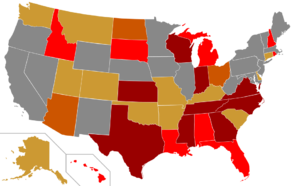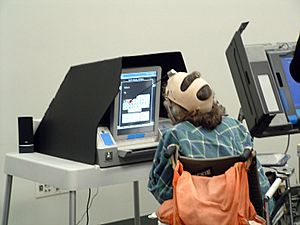Suffrage for Americans with disabilities facts for kids
Over 16% of Americans have a physical, developmental, or learning disability. This means more than 33 million people. These Americans can face challenges when they want to vote. These challenges include finding information about voting, getting into polling places, and understanding voting laws.
Contents
Why Voting Matters for People with Disabilities
Many reports show that people with disabilities are often less involved in politics than others. This means they might vote less often. For example, in the 2012 election, 11% fewer people with disabilities voted compared to those without disabilities. One study found that if people with disabilities voted at the same rate, three million more votes would have been cast.
Making Polling Places Easy to Use
One big reason why some people with disabilities don't vote is that polling places can be hard to get into. A polling place is where you go to cast your vote. Many places where people vote are not fully set up for people with disabilities. This can mean there are no ramps for wheelchairs or clear signs for accessible entrances. Voting booths themselves might also be hard to use.
Voter ID Laws Rules about showing ID when you vote can also make it harder. Many people with disabilities do not have a driver's license. In some states, you need a photo ID to vote. If you don't have one, you might have to vote by mail instead. This is called an absentee ballot.
New Voting Machines To help with these problems, new voting machines have been created. Older machines, like those using punch cards or levers, were often difficult for people with disabilities to use. Now, many machines use adaptive technology. This means they are designed to be used by more people. For example, some machines have touchscreens that can be used with special tools. The Help America Vote Act requires that every polling place has at least one machine that is easy for people with disabilities to use.
Important Laws Protecting Voting Rights
Over the years, many laws have been made to protect the rights of Americans with disabilities. Here are some of the most important ones:
Voting Accessibility for the Elderly and Handicapped Act
This law was passed in 1984. It says that all polling places must be easy for people with disabilities to use during federal elections.
Americans with Disabilities Act (ADA)
 |
|
| Other short titles | ADA |
|---|---|
| Long title | An act to establish a clear and comprehensive prohibition of discrimination on the basis of disability |
| Acronyms (colloquial) | ADA |
| Enacted by | the 101st United States Congress |
| Effective | July 26, 1990 |
| Legislative history | |
The Americans with Disabilities Act of 1990 (ADA) is a very important law. It was signed by President George H. W. Bush in 1990. The ADA makes it illegal to treat people unfairly because of a disability. This law helped make polling places more accessible. For example, it led to rules for accessible parking, drop-off areas, and building entrances at places where people vote.
Help America Vote Act (HAVA)
The Help America Vote Act (HAVA) was passed in 2002. It set up rules for how states should run elections. This law made sure that the Secretary of Health and Human Services could help make polling places accessible. HAVA especially focuses on helping people with vision problems. It requires that every polling place has at least one voting machine that is accessible for people with disabilities.
One goal of HAVA was to replace old punch-card and lever voting systems. It also created the Election Assistance Commission to help manage federal elections.
National Voter Registration Act
The National Voter Registration Act of 1993 aimed to help more people register to vote. It required government offices to help people, including those with disabilities, sign up to vote.
Civil Rights of Institutionalized Persons Act
This law was passed in 1980. The Civil Rights of Institutionalized Persons Act protects the rights of people living in places like jails, nursing homes, or special facilities for people with disabilities.
Voting Rights Act
The Voting Rights Act of 1965 was first created to stop unfair treatment based on race at polling places. More recently, it has also helped people with disabilities vote. Section 208 of this law allows someone who is blind, has a disability, or cannot read or write to have another person help them cast their vote.
Laws That Can Limit Voting Rights
In some states, people who are considered unable to make their own decisions might not be allowed to vote. This can happen through a legal process called a conservatorship. In this process, a court decides if someone needs help managing their life, and sometimes this can include losing the right to vote.



